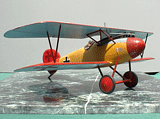
The 1/30 scale Albatros is solid wood. All the wing bays are sanded into the wing surfaces to create the stretched fabric effect. Except for my larger scale models I leave off control horns and flying wires. These are working models for my drawing and painting and I found that I would always end up breaking something off if I had these details. This model is all wood except for brass struts and landing gear. The wheels are turned on my lathe out of wood. The approach to the model was like the models of the thirties, where you got a box full of wood blanks, and I let that limit the detail in respect to the engine. The model completely breaks down because everything is press fit with pins. The reason for this is when I was traveling a lot between California and Florida, I had the parts fitted in one of my briefcases and could work on it in a hotel. It also saved the plane's life when my wife accidentally backed into it with the vacuum cleaner hose. The paint work was all brushed with Dr. Martins airbrush paints. They lay down an extremely thin coat. I always start with the factory finish before laying on squadron or personal colors as in the case of Richthofen. I also paint all my insignia except in 48th scale plastic models where I use decals.
The DVIII is 28th scale and is another solid wood model. The lozenge drove me nuts. Its all airbrush lacquer using frisket for each color.
The 1/8th scale Albatros DV is built from scratch. It started it's life engineered to be an electric powered RC model by my ex-partner and friend Simon Smith. He gave up on it and it sat unfinished for years in his shop collecting dust. When he gave it to me it was in as bad shape as Stropp was at the Air and Space Museum prior to its restoration. I built the spandaus from scratch and all the rest of the parts. I have a detail of the guns if you are interested. The fuselage was covered in balsa and had so many CA stains on it would have been impossible to stain a natural wood finish. To solve the problem, I sprayed the surface with a flat tan lacquer. Then I taped off the factory ply panels one at a time and used watercolor burnt umber with a 1" brush to create the wood grain. This was oversprayed with clear lacquer to protect the brush work. I then repeated the same procedure for each panel.